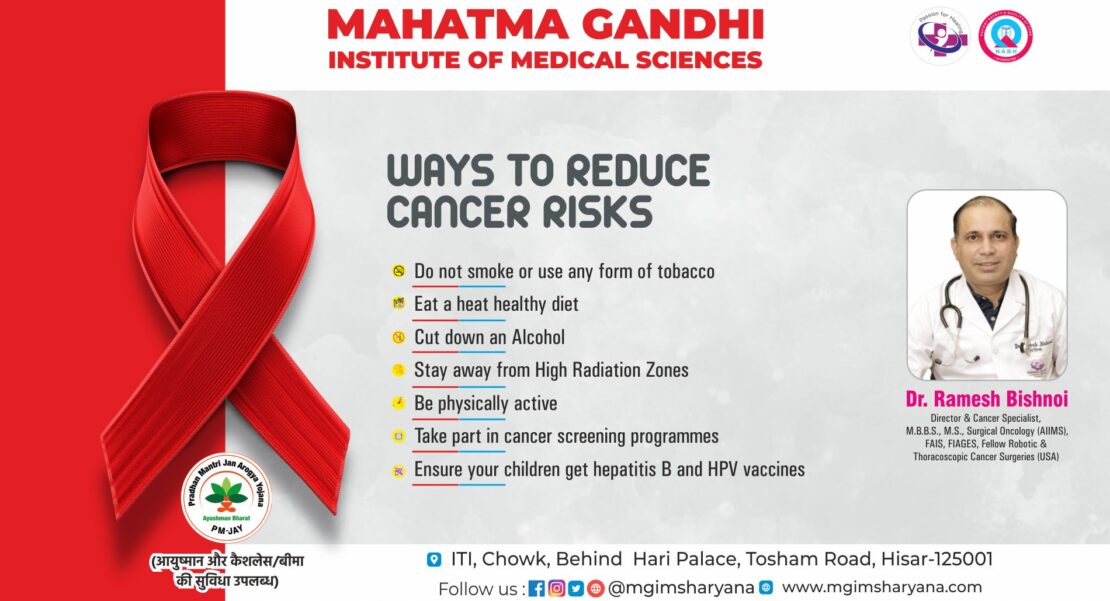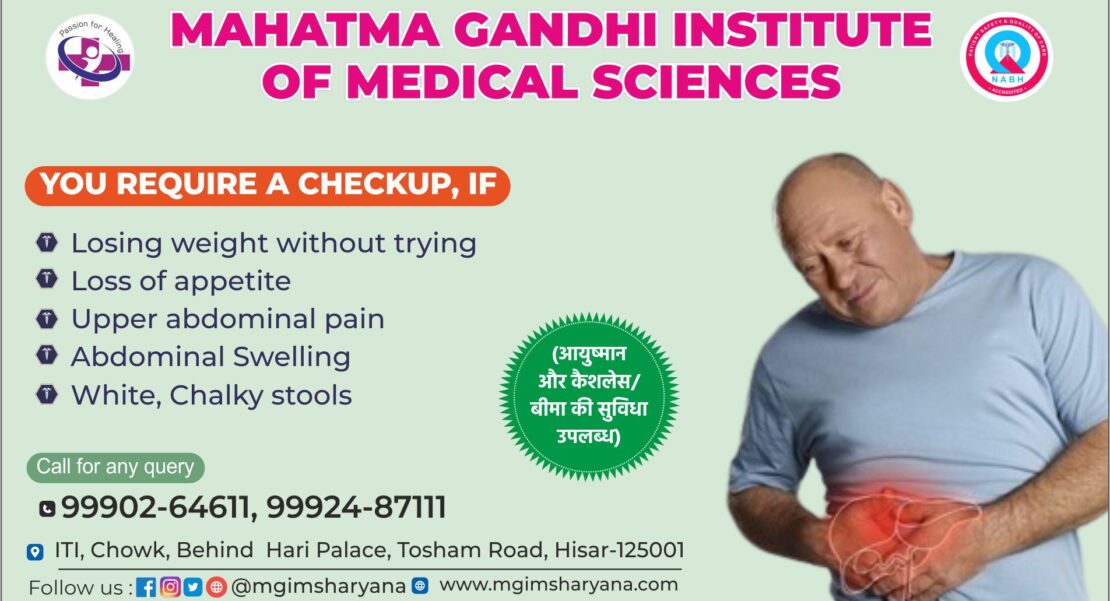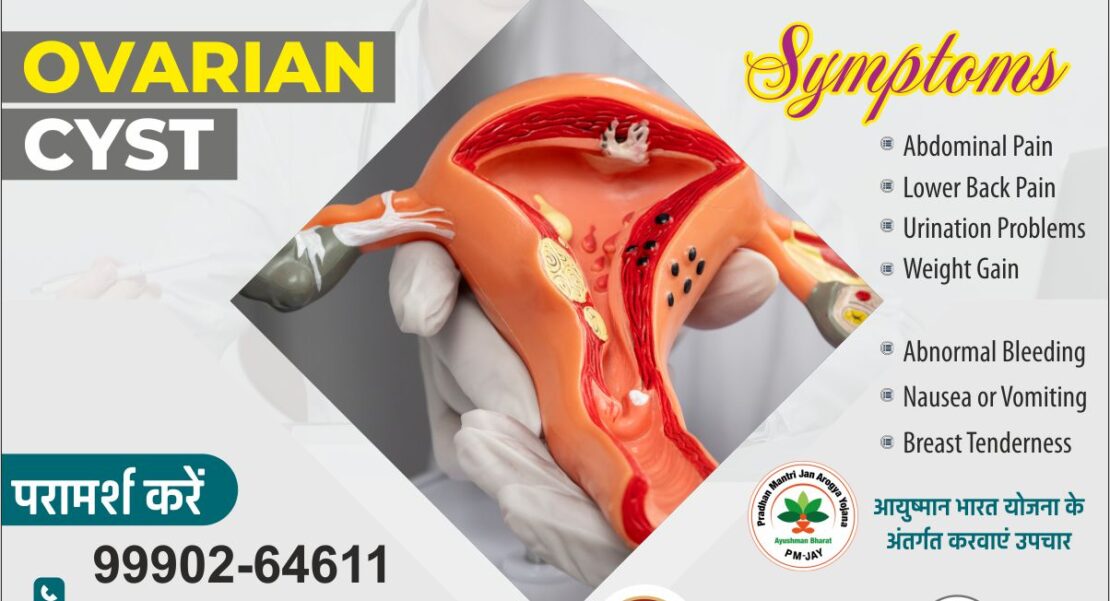स्वच्छ और स्वस्थ त्वचा, आत्मविश्वास की कुंजी
महात्मा गांधी इंस्टीट्यूट ऑफ मेडिकल साईंसिज होस्पिटल एक प्रमुख स्वास्थ्य सेवा प्रदाता है और यहाँ त्वचा समस्याओं का इलाज भी किया जाता है। यहाँ प्रमुख त्वचा समस्याओं का इलाज शामिल हो सकता है:
लीवर कैंसर: अत्याधुनिक तकनीक, बेहतरीन परिणाम
लीवर कैंसर एक गंभीर बीमारी है जिसमें लीवर की कोशिकाएं अनियंत्रित रूप से बढ़ने लगती हैं। यह भारत में मौत का एक प्रमुख कारण है। लीवर कैंसर के शुरुआती चरणों में अक्सर कोई लक्षण नहीं दिखाई देते हैं, लेकिन जैसे-जैसे कैंसर बढ़ता है, निम्नलिखित लक्षण दिखाई दे सकते हैं:
पित की थैली कैंसर: लक्षण और उपचार
पित की थैली कैंसर एक गंभीर रोग है जो धीरे-धीरे विकसित होता है और पित की थैली के ऊतकों में कैंसर की उत्पत्ति को उत्पन्न करता है। यह रोग अक्सर शुरूआत में लक्षणों की कमी व अज्ञानता के कारण अधिकांश लोगों को पता नहीं चल पाता है।

आयुष्मान योजना में पित्ताशय कैंसर के उपचार:
कीमोथेरेपी: आयुष्मान योजना के तहत कीमोथेरेपी का खर्च भी सरकार द्वारा वहन किया जाता है।
ब्रेन ट्यूमर के लक्षणों को पहचानें और इलाज शुरू करें
ब्रेन ट्यूमर मस्तिष्क में असामान्य कोशिकाओं का समूह होता है। यह कैंसरग्रस्त या गैर-कैंसरग्रस्त (सौम्य) हो सकता है। ब्रेन ट्यूमर मस्तिष्क के किसी भी हिस्से में शुरू हो सकते हैं और किसी भी उम्र में हो सकते हैं। वे पुरुषों में महिलाओं की तुलना में अधिक आम हैं।
ओवेरियन रिस्ट इलाज: दर्द और निराशा को दूर करें
ओवेरियन सिस्ट, या अंडाशय की गांठ, महिलाओं में होने वाली एक आम समस्या है। यह अंडाशय के भीतर या सतह पर एक थैली होती है जिसमें तरल पदार्थ, द्रव या अन्य पदार्थ भरा होता है। ओवेरियन सिस्ट दो प्रकार के होते हैं:
कार्यात्मक सिस्ट:
ये सिस्ट मासिक धर्म चक्र के हिस्से के रूप में विकसित होते हैं और आमतौर पर बिना किसी उपचार के अपने आप समाप्त हो जाते हैं।
पैथोलॉजिकल सिस्ट: ये सिस्ट अधिक गंभीर होते हैं और उपचार की आवश्यकता हो सकती है। ओवेरियन सिस्ट के उपचार की आवश्यकता या नहीं, यह सिस्ट के प्रकार, आकार और लक्षणों पर निर्भर करता है।
कार्यात्मक सिस्ट:
ये सिस्ट मासिक धर्म चक्र के हिस्से के रूप में विकसित होते हैं और आमतौर पर बिना किसी उपचार के अपने आप समाप्त हो जाते हैं।
पैथोलॉजिकल सिस्ट: ये सिस्ट अधिक गंभीर होते हैं और उपचार की आवश्यकता हो सकती है। ओवेरियन सिस्ट के उपचार की आवश्यकता या नहीं, यह सिस्ट के प्रकार, आकार और लक्षणों पर निर्भर करता है।
कैंसर की समस्या होने पर तुरंत अस्पताल में विजिट करें व इलाज करवाएं: महात्मा गांधी इंस्टीट्यूट ऑफ मेडिकल साईंसिज
कैंसर एक गंभीर बीमारी है जिसमें अनियमित रूप से बढ़ते अनियंत्रित कोशिकाएं शरीर के विभिन्न हिस्सों में उत्पन्न होती हैं। इस बीमारी का समय पर पहचानना और उचित इलाज प्राप्त करना अत्यंत महत्वपूर्ण है। महात्मा गांधी इंस्टीट्यूट ऑफ मेडिकल साईंसिज, जो एक प्रमुख अस्पताल है, इसमें मदद कर सकता है।
What do you need to know about cervical Cancer?
The cervix is also known as the neck of the uterus. Cancer of cervix is the 2nd most common cancer seen in females contributing to 18.3% of all female cancers in Indian women. More than 1 lakh new cases are being diagnosed per year in India. Approximately 77,000 women lose their lives to this cancer per year in India. This cancer affects women between 35-45 years of age.
The most common symptoms are abnormal uterine bleeding and post coital bleeding more specifically. Other symptoms can be a foul smelling discharge from the vagina, weight loss, swelling in the legs, etc. Factors like early start of sexual activity, younger age at marriage, more than 5 lifetime sexual partners, multiple childbirths, poor hygiene, infections with sexually transmitted diseases, and oral contraceptive use make women high risk for cervical cancer.
Unfortunately patients present at an advanced stage to the hospital for which treatments like radiotherapy with chemotherapy can achieve cure rates of 40-50%. However if a patient comes at an early stage, surgery can achieve a cure rate of up to 90%.
This cancer has a long preinvasive phase due to which detection of cervical lesions which lead to the development of cervical cancer in future and treating them can totally prevent this cancer.
Thus, screening asymptomatic women plays an essential role. A simple and painless test called as Pap smear done at regular intervals can help in reducing the burden of cervical cancer significantly. Since 99% of cervical cancers arise from persistent Human Papilloma Virus (HPV) infection, vaccination against HPV has the potential to eliminate cervical cancer. If given at appropriate age before the start of sexual activity to adolescent girls, vaccine efficacy approaches 100% in preventing type specific HPV persistence.
World Health Organization (WHO) recommends vaccinating girls between 9-14 years of age with 2 doses of HPV vaccine and girls of age 15years or above up to 26 years can be vaccinated with 3 doses of HPV vaccine. This vaccine is highly effective and safe to use. It is highly commendable that India will have its indigenous vaccine against HPV available very soon. Thus consult your Gynaecologist/Gynecological Oncologist today.
The most common symptoms are abnormal uterine bleeding and post coital bleeding more specifically. Other symptoms can be a foul smelling discharge from the vagina, weight loss, swelling in the legs, etc. Factors like early start of sexual activity, younger age at marriage, more than 5 lifetime sexual partners, multiple childbirths, poor hygiene, infections with sexually transmitted diseases, and oral contraceptive use make women high risk for cervical cancer.
Unfortunately patients present at an advanced stage to the hospital for which treatments like radiotherapy with chemotherapy can achieve cure rates of 40-50%. However if a patient comes at an early stage, surgery can achieve a cure rate of up to 90%.
This cancer has a long preinvasive phase due to which detection of cervical lesions which lead to the development of cervical cancer in future and treating them can totally prevent this cancer.
Thus, screening asymptomatic women plays an essential role. A simple and painless test called as Pap smear done at regular intervals can help in reducing the burden of cervical cancer significantly. Since 99% of cervical cancers arise from persistent Human Papilloma Virus (HPV) infection, vaccination against HPV has the potential to eliminate cervical cancer. If given at appropriate age before the start of sexual activity to adolescent girls, vaccine efficacy approaches 100% in preventing type specific HPV persistence.
World Health Organization (WHO) recommends vaccinating girls between 9-14 years of age with 2 doses of HPV vaccine and girls of age 15years or above up to 26 years can be vaccinated with 3 doses of HPV vaccine. This vaccine is highly effective and safe to use. It is highly commendable that India will have its indigenous vaccine against HPV available very soon. Thus consult your Gynaecologist/Gynecological Oncologist today.
Mahatma Gandhi Institute of Medical Sciences, Hisar: A Leading Cancer Hospital Focused on Excellence in Care
Looking for the top cancer hospital in Hisar for yourself or your loved one? you are at the right place When it comes to battling cancer, having access to world-class medical expertise and state-of-the-art facilities is paramount. In the city of Hisar, the Mahatma Gandhi Institute of Medical Sciences (MGIMS) stands tall as a leading cancer hospital. Renowned for its commitment to excellence in healthcare, MGIMS has gained recognition for its exceptional cancer treatment services and compassionate patient care.
Cutting-Edge Infrastructure and Facilities: MGIMS boasts an impressive infrastructure, incorporating modern facilities and advanced technology to provide comprehensive cancer care. The hospital is equipped with cutting-edge diagnostic tools, including advanced imaging techniques and laboratory services, enabling accurate and timely cancer detection. Additionally, MGIMS houses state-of-the-art radiation therapy machines, surgical suites, and specialized oncology wards, ensuring that patients receive the highest quality treatment available.
Expert Oncologists and Multidisciplinary Team: At MGIMS, a team of highly skilled oncologists and healthcare professionals lies at the heart of their success. The hospital attracts renowned medical experts specializing in various facets of oncology, including medical oncology, surgical oncology, radiation oncology, and supportive care. This multidisciplinary team collaborates closely to develop personalized treatment plans, leveraging their expertise and knowledge to provide patients with the best possible care.
Comprehensive Cancer Treatments: MGIMS offers a comprehensive range of cancer treatments, covering various types and stages of the disease. The hospital follows evidence-based practices and adopts a multidimensional approach to cancer care. This includes chemotherapy, radiation therapy, immunotherapy, targeted therapy, minimally invasive surgeries, and palliative care. By tailoring treatment plans to individual patients, MGIMS ensures that each person receives the most suitable and effective treatment for their specific condition.
Patient-Centric Care: At MGIMS, a patient-centric approach is central to their philosophy of care. The hospital understands the emotional and physical challenges faced by cancer patients and their families and strives to create a supportive and compassionate environment. The medical staff at MGIMS are known for their empathy, understanding, and dedication to providing personalized attention to each patient. They go above and beyond to offer emotional support, address concerns, and guide patients through every step of their cancer journey.
Research and Innovation: MGIMS is committed to advancing the field of cancer care through research and innovation. The hospital actively participates in clinical trials, collaborates with esteemed research institutions, and conducts its research to further the understanding and treatment of cancer. By staying at the forefront of medical research and technological advancements, MGIMS ensures that patients have access to the latest treatment options, experimental therapies, and cutting-edge advancements in cancer care.
Community Outreach and Education: MGIMS plays an active role in the community by organizing awareness programs, cancer screenings, and educational initiatives. The hospital strives to raise awareness about cancer prevention, early detection, and the importance of regular check-ups. Through these efforts, MGIMS aims to empower individuals with knowledge, promote early intervention, and reduce the burden of cancer in the community.
Conclusion: The Mahatma Gandhi Institute of Medical Sciences (MGIMS) in Hisar has earned its reputation as a top cancer hospital, offering exceptional healthcare services, advanced infrastructure, a multidisciplinary team of experts, patient-centric care, and a focus on research and innovation. With its unwavering commitment to excellence in cancer treatment and support, MGIMS continues to make a significant impact in the field of oncology. For cancer patients and their loved ones in Hisar, MGIMS serves as a beacon of hope, providing world-class care and fostering an environment of compassion and healing.
Cutting-Edge Infrastructure and Facilities: MGIMS boasts an impressive infrastructure, incorporating modern facilities and advanced technology to provide comprehensive cancer care. The hospital is equipped with cutting-edge diagnostic tools, including advanced imaging techniques and laboratory services, enabling accurate and timely cancer detection. Additionally, MGIMS houses state-of-the-art radiation therapy machines, surgical suites, and specialized oncology wards, ensuring that patients receive the highest quality treatment available.
Expert Oncologists and Multidisciplinary Team: At MGIMS, a team of highly skilled oncologists and healthcare professionals lies at the heart of their success. The hospital attracts renowned medical experts specializing in various facets of oncology, including medical oncology, surgical oncology, radiation oncology, and supportive care. This multidisciplinary team collaborates closely to develop personalized treatment plans, leveraging their expertise and knowledge to provide patients with the best possible care.
Comprehensive Cancer Treatments: MGIMS offers a comprehensive range of cancer treatments, covering various types and stages of the disease. The hospital follows evidence-based practices and adopts a multidimensional approach to cancer care. This includes chemotherapy, radiation therapy, immunotherapy, targeted therapy, minimally invasive surgeries, and palliative care. By tailoring treatment plans to individual patients, MGIMS ensures that each person receives the most suitable and effective treatment for their specific condition.
Patient-Centric Care: At MGIMS, a patient-centric approach is central to their philosophy of care. The hospital understands the emotional and physical challenges faced by cancer patients and their families and strives to create a supportive and compassionate environment. The medical staff at MGIMS are known for their empathy, understanding, and dedication to providing personalized attention to each patient. They go above and beyond to offer emotional support, address concerns, and guide patients through every step of their cancer journey.
Research and Innovation: MGIMS is committed to advancing the field of cancer care through research and innovation. The hospital actively participates in clinical trials, collaborates with esteemed research institutions, and conducts its research to further the understanding and treatment of cancer. By staying at the forefront of medical research and technological advancements, MGIMS ensures that patients have access to the latest treatment options, experimental therapies, and cutting-edge advancements in cancer care.
Community Outreach and Education: MGIMS plays an active role in the community by organizing awareness programs, cancer screenings, and educational initiatives. The hospital strives to raise awareness about cancer prevention, early detection, and the importance of regular check-ups. Through these efforts, MGIMS aims to empower individuals with knowledge, promote early intervention, and reduce the burden of cancer in the community.
Conclusion: The Mahatma Gandhi Institute of Medical Sciences (MGIMS) in Hisar has earned its reputation as a top cancer hospital, offering exceptional healthcare services, advanced infrastructure, a multidisciplinary team of experts, patient-centric care, and a focus on research and innovation. With its unwavering commitment to excellence in cancer treatment and support, MGIMS continues to make a significant impact in the field of oncology. For cancer patients and their loved ones in Hisar, MGIMS serves as a beacon of hope, providing world-class care and fostering an environment of compassion and healing.
Early Cancer Detection for Proactive Risk Management
Did you know 50% of cancers is still found in the late stages? (1)
A late-stage cancer diagnosis can be attributed to many factors such as postponing cancer screening or a lack of convenient screening options. Aristotle® is a novel blood test that can detect 8 cancers in women and 6 cancers in men from a single sample of blood. If you have a family history of cancer or other risk factors, don’t wait for symptoms to appear. Be proactive and get a convenient blood test so that you can act earlier.
A late-stage cancer diagnosis can be attributed to many factors such as postponing cancer screening or a lack of convenient screening options. Aristotle® is a novel blood test that can detect 8 cancers in women and 6 cancers in men from a single sample of blood. If you have a family history of cancer or other risk factors, don’t wait for symptoms to appear. Be proactive and get a convenient blood test so that you can act earlier.











